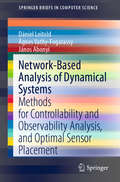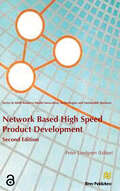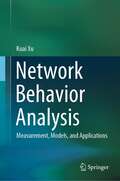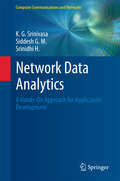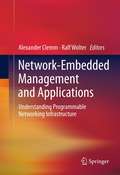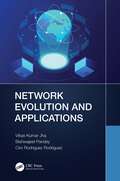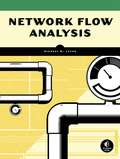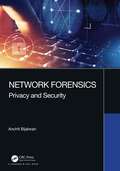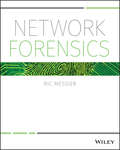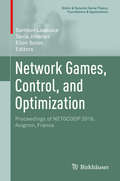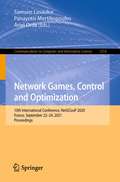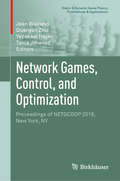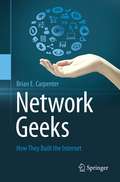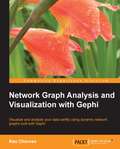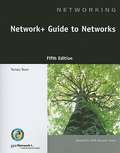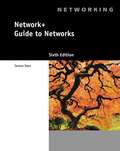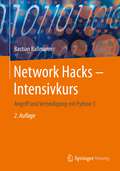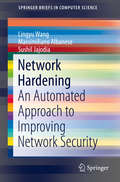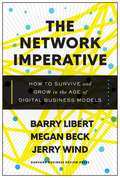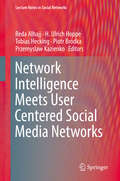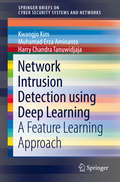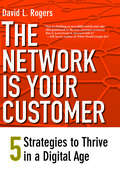- Table View
- List View
Network-Based Analysis of Dynamical Systems: Methods for Controllability and Observability Analysis, and Optimal Sensor Placement (SpringerBriefs in Computer Science)
by János Abonyi Ágnes Vathy-Fogarassy Dániel LeitoldThis book explores the key idea that the dynamical properties of complex systems can be determined by effectively calculating specific structural features using network science-based analysis. Furthermore, it argues that certain dynamical behaviours can stem from the existence of specific motifs in the network representation.Over the last decade, network science has become a widely applied methodology for the analysis of dynamical systems. Representing the system as a mathematical graph allows several network-based methods to be applied, and centrality and clustering measures to be calculated in order to characterise and describe the behaviours of dynamical systems. The applicability of the algorithms developed here is presented in the form of well-known benchmark examples. The algorithms are supported by more than 50 figures and more than 170 references; taken together, they provide a good overview of the current state of network science-based analysis of dynamical systems, and suggest further reading material for researchers and students alike. The files for the proposed toolbox can be downloaded from a corresponding website.
Network Based High Speed Product Development
by Peter LindgrenIn the first decade of the 21st century product development in networks was predicted to be of ever-increasing importance to businesses of all sizes because of changes in markets, in technology, in networks, and in the competences of Businesses. The growth in new products’ share of businesses’ total turnover and earnings were increasing at an unprecedented speed. The entrepreneurial innovations and technological improvements had resulted in the increasingly fast development of new products and services. Businesses and industries in different countries became increasingly more linked and interdependent in networks with respect to materials, business operations and particularly product development to match the wants and needs of the global market environment to high speed product development. Businesses were therefore encountering increasingly dynamic market fragmentation, shrinking time in market, increasing product variety, demands of production to customer specifications, reduced product lifetimes, and globalization of production.Networks were vital because the competition is not business against business, but network against network. Networks are vital because an increasing part of product development was carried out in all types of networks containing physical, ICT, dynamic, and virtual networks. Speed and pressure on time in product development seemed to continue to increase because customer demands for new products seemed to continue to increase. However, a Business seldom possessed all needed competences, and managers saw product development based on networks as an important solution to meet the strong competition of the future global markets and the strong demand for innovation and innovativeness. The evolution of market demands and focus (required) on competencies of businesses could be characterized as a development from a focus on efficiency, to a focus on quality and flexibility, to a focus on speed and innovativeness.This was why it was interesting and important to research and discuss product development and especially to understand high speed product development of individualized products in fragile market segments. Consequently, findings and learning on aspects like enablers, management tools, technological tools, product development models, product development processes and network tools to speed new product development are presented in this book.
Network Behavior Analysis: Measurement, Models, and Applications
by Kuai XuThis book provides a comprehensive overview of network behavior analysis that mines Internet traffic data in order to extract, model, and make sense of behavioral patterns in Internet “objects” such as end hosts, smartphones, Internet of things, and applications. The objective of this book is to fill the book publication gap in network behavior analysis, which has recently become an increasingly important component of comprehensive network security solutions for data center networks, backbone networks, enterprise networks, and edge networks.The book presents fundamental principles and best practices for measuring, extracting, modeling and analyzing network behavior for end hosts and applications on the basis of Internet traffic data. In addition, it explains the concept and key elements (e.g., what, who, where, when, and why) of communication patterns and network behavior of end hosts and network applications, drawing on data mining, machine learning, information theory, probabilistic graphical and structural modeling to do so. The book also discusses the benefits of network behavior analysis for applications in cybersecurity monitoring, Internet traffic profiling, anomaly traffic detection, and emerging application detections.The book will be of particular interest to researchers and practitioners in the fields of Internet measurement, traffic analysis, and cybersecurity, since it provides a spectrum of innovative techniques for summarizing behavior models, structural models, and graphic models of Internet traffic, and explains how to leverage the results for a broad range of real-world applications in network management, security operations, and cyber-intelligent analysis. After finishing this book, readers will 1) have learned the principles and practices of measuring, modeling, and analyzing network behavior on the basis of massive Internet traffic data; 2) be able to make sense of network behavior for a spectrum of applications ranging from cybersecurity and network monitoring to emerging application detection; and 3) understand how to explore network behavior analysis to complement traditional perimeter-based firewall and intrusion detection systems in order to detect unusual traffic patterns or zero-day security threats using data mining and machine learning techniques. To ideally benefit from this book, readers should have a basic grasp of TCP/IP protocols, data packets, network flows, and Internet applications.
Network Data Analytics: A Hands-on Approach For Application Development (Computer Communications and Networks)
by Srinidhi H. Siddesh G. M. K. G. SrinivasaIn order to carry out data analytics, we need powerful and flexible computing software. However the software available for data analytics is often proprietary and can be expensive. This book reviews Apache tools, which are open source and easy to use. After providing an overview of the background of data analytics, covering the different types of analysis and the basics of using Hadoop as a tool, it focuses on different Hadoop ecosystem tools, like Apache Flume, Apache Spark, Apache Storm, Apache Hive, R, and Python, which can be used for different types of analysis. It then examines the different machine learning techniques that are useful for data analytics, and how to visualize data with different graphs and charts. Presenting data analytics from a practice-oriented viewpoint, the book discusses useful tools and approaches for data analytics, supported by concrete code examples. The book is a valuable reference resource for graduate students and professionals in related fields, and is also of interest to general readers with an understanding of data analytics.
Network Economics and the Allocation of Savings
by Philipp ServatiusThis book provides a game theoretic model of interaction among VoIP telecommunications providers regarding their willingness to enter peering agreements with one another. The author shows that the incentive to peer is generally based on savings from otherwise payable long distance fees. At the same time, termination fees can have a countering and dominant effect, resulting in an environment in which VoIP firms decide against peering. Various scenarios of peering and rules for allocation of the savings are considered. The first part covers the relevant aspects of game theory and network theory, trying to give an overview of the concepts required in the subsequent application. The second part of the book introduces first a model of how the savings from peering can be calculated and then turns to the actual formation of peering relationships between VoIP firms. The conditions under which firms are willing to peer are then described, considering the possible influence of a regulatory body.
Network-Embedded Management and Applications
by Ralf Wolter Alexander ClemmDespite the explosion of networking services and applications in the past decades, the basic technological underpinnings of the Internet have remained largely unchanged. At its heart are special-purpose appliances that connect us to the digital world, commonly known as switches and routers. Now, however, the traditional framework is being increasingly challenged by new methods that are jostling for a position in the "next-generation" Internet. The concept of a network that is becoming more programmable is one of the aspects that are taking center stage. This opens new possibilities to embed software applications inside the network itself and to manage networks and communications services with unprecedented ease and efficiency. In this edited volume, distinguished experts take the reader on a tour of different facets of programmable network infrastructure and applications that exploit it. Presenting the state of the art in network embedded management and applications and programmable network infrastructure, the book conveys fundamental concepts and provides a glimpse into various facets of the latest technology in the field.
Network Evolution and Applications
by Vikas Kumar Jha Bishwajeet Kumar Pandey Ciro RodriguezNetwork Evolution and Applications provides a comprehensive, integrative, and easy approach to understanding the technologies, concepts, and milestones in the history of networking. It provides an overview of different aspects involved in the networking arena that includes the core technologies that are essential for communication and important in our day-to-day life. It throws some light on certain past networking concepts and technologies that have been revolutionary in the history of science and technology and have been highly impactful. It expands on various concepts like Artificial Intelligence, Software Defined Networking, Cloud Computing, and Internet of Things, which are very popular at present. This book focuses on the evolutions made in the world of networking. One can’t imagine the world without the Internet today; with the Internet and the present- day networking, distance doesn’t matter at all. The COVID-19 pandemic has resulted in a tough time worldwide, with global lockdown, locked homes, empty streets, stores without consumers, and offices with no or fewer staff. Thanks to the modern digital networks, the culture of work from home (WFH) or working remotely with the network/Internet connection has come to the fore, with even school and university classes going online. Although WFH is not new, the COVID-19 pandemic has given it a new look, and industries are now willfully exploring WFH to extend it in the future. The aim of this book is to present the timeline of networking to show the developments made and the milestones that were achieved due to these developments.
Network Flow Algorithms
by David P. WilliamsonNetwork flow theory has been used across a number of disciplines, including theoretical computer science, operations research, and discrete math, to model not only problems in the transportation of goods and information, but also a wide range of applications from image segmentation problems in computer vision to deciding when a baseball team has been eliminated from contention. This graduate text and reference presents a succinct, unified view of a wide variety of efficient combinatorial algorithms for network flow problems, including many results not found in other books. It covers maximum flows, minimum-cost flows, generalized flows, multicommodity flows, and global minimum cuts and also presents recent work on computing electrical flows along with recent applications of these flows to classical problems in network flow theory.
Network Flow Analysis (No Starch Press Ser.)
by Michael W. LucasYou know that servers have log files and performance measuring tools and that traditional network devices have LEDs that blink when a port does something. You may have tools that tell you how busy an interface is, but mostly a network device is a black box. Network Flow Analysis opens that black box, demonstrating how to use industry-standard software and your existing hardware to assess, analyze, and debug your network.Unlike packet sniffers that require you to reproduce network problems in order to analyze them, flow analysis lets you turn back time as you analyze your network. You'll learn how to use open source software to build a flow-based network awareness system and how to use network analysis and auditing to address problems and improve network reliability. You'll also learn how to use a flow analysis system; collect flow records; view, filter, and report flows; present flow records graphically; and use flow records to proactively improve your network. Network Flow Analysis will show you how to:–Identify network, server, router, and firewall problems before they become critical–Find defective and misconfigured software–Quickly find virus-spewing machines, even if they’re on a different continent–Determine whether your problem stems from the network or a server–Automatically graph the most useful dataAnd much more. Stop asking your users to reproduce problems. Network Flow Analysis gives you the tools and real-world examples you need to effectively analyze your network flow data. Now you can determine what the network problem is long before your customers report it, and you can make that silly phone stop ringing.
Network Forensics: Privacy and Security
by Anchit BijalwanThis book primarily focuses on providing deep insight into the concepts of network security, network forensics, botnet forensics, ethics and incident response in global perspectives. It also covers the dormant and contentious issues of the subject in most scientific and objective manner. Various case studies addressing contemporary network forensics issues are also included in this book to provide practical know – how of the subject. Network Forensics: A privacy & Security provides a significance knowledge of network forensics in different functions and spheres of the security. The book gives the complete knowledge of network security, all kind of network attacks, intention of an attacker, identification of attack, detection, its analysis, incident response, ethical issues, botnet and botnet forensics. This book also refer the recent trends that comes under network forensics. It provides in-depth insight to the dormant and latent issues of the acquisition and system live investigation too. Features: Follows an outcome-based learning approach. A systematic overview of the state-of-the-art in network security, tools, Digital forensics. Differentiation among network security, computer forensics, network forensics and botnet forensics. Discussion on various cybercrimes, attacks and cyber terminologies. Discussion on network forensics process model. Network forensics tools and different techniques Network Forensics analysis through case studies. Discussion on evidence handling and incident response. System Investigations and the ethical issues on network forensics. This book serves as a reference book for post graduate and research investigators who need to study in cyber forensics. It can also be used as a textbook for a graduate level course in Electronics & Communication, Computer Science and Computer Engineering.
Network Forensics
by Ric MessierIntensively hands-on training for real-world network forensics Network Forensics provides a uniquely practical guide for IT and law enforcement professionals seeking a deeper understanding of cybersecurity. This book is hands-on all the way—by dissecting packets, you gain fundamental knowledge that only comes from experience. Real packet captures and log files demonstrate network traffic investigation, and the learn-by-doing approach relates the essential skills that traditional forensics investigators may not have. From network packet analysis to host artifacts to log analysis and beyond, this book emphasizes the critical techniques that bring evidence to light. Network forensics is a growing field, and is becoming increasingly central to law enforcement as cybercrime becomes more and more sophisticated. This book provides an unprecedented level of hands-on training to give investigators the skills they need. Investigate packet captures to examine network communications Locate host-based artifacts and analyze network logs Understand intrusion detection systems—and let them do the legwork Have the right architecture and systems in place ahead of an incident Network data is always changing, and is never saved in one place; an investigator must understand how to examine data over time, which involves specialized skills that go above and beyond memory, mobile, or data forensics. Whether you're preparing for a security certification or just seeking deeper training for a law enforcement or IT role, you can only learn so much from concept; to thoroughly understand something, you need to do it. Network Forensics provides intensive hands-on practice with direct translation to real-world application.
Network Games, Control, and Optimization
by Samson Lasaulce Tania Jimenez Eilon SolanThis contributed volume offers a collection of papers presented at the 2016 Network Games, Control, and Optimization conference (NETGCOOP), held at the University of Avignon in France, November 23-25, 2016. These papers highlight the increasing importance of network control and optimization in many networking application domains, such as mobile and fixed access networks, computer networks, social networks, transportation networks, and, more recently, electricity grids and biological networks. Covering a wide variety of both theoretical and applied topics in the areas listed above, the authors explore several conceptual and algorithmic tools that are needed for efficient and robust control operation, performance optimization, and better understanding the relationships between entities that may be acting cooperatively or selfishly in uncertain and possibly adversarial environments. As such, this volume will be of interest to applied mathematicians, computer scientists, engineers, and researchers in other related fields.
Network Games, Control and Optimization: 10th International Conference, NetGCooP 2020, France, September 22–24, 2021, Proceedings (Communications in Computer and Information Science #1354)
by Samson Lasaulce Panayotis Mertikopoulos Ariel OrdaThis book constitutes the conference proceedings of the 10th International Conference on Network Games, Control and Optimization, NETGCOOP 2020, held in Cargèse, Corsica, France, in September 2021*.The 12 full papers and 16 short papers were carefully reviewed and selected from 44 submissions. The papers are organized in the following topical sections: game theory and iterative algorithms applied to wireless communication; stochastic models for network performance analysis; game theory in mobile and wireless networks; scheduling and resource allocation problems in networks; advance in game theory; social network; electrical network.* The conference was postponed to 2021 due to the COVID-19 pandemic.
Network Games, Control, and Optimization: Proceedings Of Netgcoop 2016, Avignon, France (Static & Dynamic Game Theory: Foundations & Applications)
by Jean Walrand Quanyan Zhu Yezekael Hayel Tania JimenezThis contributed volume offers a collection of papers presented at the 2016 Network Games, Control, and Optimization conference (NETGCOOP), held at the University of Avignon in France, November 23-25, 2016. These papers highlight the increasing importance of network control and optimization in many networking application domains, such as mobile and fixed access networks, computer networks, social networks, transportation networks, and, more recently, electricity grids and biological networks. Covering a wide variety of both theoretical and applied topics in the areas listed above, the authors explore several conceptual and algorithmic tools that are needed for efficient and robust control operation, performance optimization, and better understanding the relationships between entities that may be acting cooperatively or selfishly in uncertain and possibly adversarial environments. As such, this volume will be of interest to applied mathematicians, computer scientists, engineers, and researchers in other related fields.
Network Geeks
by Brian E CarpenterThe impact on modern society made by the Internet is immeasurable. Yet some questioned "why anyone would want such a thing" when the idea was first introduced. Part history, part memoir and part cultural study, Network Geeks charts the creation of the Internet and the establishment of the Internet Engineering Task Force, from the viewpoint of a self-proclaimed geek who witnessed these developments first-hand. With boundless enthusiasm and abundant humour, Brian Carpenter leads the reader on a journey from post-war Britain to post-millennium New Zealand, describing how the Internet grew into today's ubiquitous, global network, including the genesis of the World-Wide Web in the hotbeds of a particle collider at CERN. Illuminating the science and technology behind the apparent "magic trick" of the Internet, Network Geeks opens a window into the initially bewildering world of the Internet engineering geek. After reading this book, you may wish to join this world yourself.
Network Graph Analysis and Visualization with Gephi
by Ken ChervenA practical, hands-on guide, that provides you with all the tools you need to visualize and analyze your data using network graphs with Gephi.This book is for data analysts who want to intuitively reveal patterns and trends, highlight outliers, and tell stories with their data using Gephi. It is great for anyone looking to explore interactions within network datasets, whether the data comes from social media or elsewhere. It is also a valuable resource for those seeking to learn more about Gephi without being overwhelmed by technical details.
Network+ Guide to Networks (5th edition)
by Tamara DeanThis book introduces the fundamental building blocks that form a modern network, such as protocols, topologies, hardware, and network operating systems. It then provides in-depth coverage of the most important concepts in contemporary networking, such as TCP/IP, Ethernet, wireless transmission, and security.
Network+ Guide to Networks 6th Edition
by Tamara DeanThe completely updated NETWORK+ GUIDE TO NETWORKS, 6th Edition gives readers the technical skills and industry know-how required to begin an exciting career installing, configuring, and troubleshooting computer networks. The text also prepares readers for CompTIA's Network+ N10-005 certification exam with fundamentals in protocols, topologies, hardware, and network design. After exploring TCP/IP, Ethernet, wireless transmission, and security concepts, as well as an all-new chapter on virtual networks, readers can increase their knowledge with the practical "On-the Job" stories, Review Questions, Hands-On Projects, and Case Projects
Network Hacks - Intensivkurs: Angriff und Verteidigung mit Python 3 (Xpert. Press Ser.)
by Bastian BallmannDas Buch verhilft Lesern dazu, das eigene Netz mit den Augen des Angreifers zu sehen – um seine Techniken zu verstehen und um sich besser schützen zu können. Anhand von Python-Codebeispielen erläutert der Autor Themen wie Passwort Sniffing, ARP Poisoning, DNS Spoofing, SQL Injection, Google Hacking, WEP Cracking und WLAN Hacking. Zu jedem Gebiet stellt er außerdem ein Open-Source-Projekt in Python vor und behandelt darüber hinaus auch klassische Verteidigungsverfahren wie Intrusion-Detection-Systeme, Intrusion Prevention und Logfile-Analyse.
Network Hardening
by Lingyu Wang Massimiliano Albanese Sushil JajodiaThis Springer Brief examines the tools based on attack graphs that help reveal network hardening threats. Existing tools detail all possible attack paths leading to critical network resources. Though no current tool provides a direct solution to remove the threats, they are a more efficient means of network defense than relying solely on the experience and skills of a human analyst. Key background information on attack graphs and network hardening helps readers understand the complexities of these tools and techniques. A common network hardening technique generates hardening solutions comprised of initially satisfied conditions, thereby making the solution more enforceable. Following a discussion of the complexity issues in this technique, the authors provide an improved technique that considers the dependencies between hardening options and employs a near-optimal approximation algorithm to scale linearly with the size of the inputs. Also included are automated solutions for hardening a network against sophisticated multi-step intrusions. Network Hardening: An Automated Approach to Improving Network Security is a valuable resource for researchers and professionals working in network security. It is also a useful tool for advanced-level students focused on security in computer science and electrical engineering.
The Network Imperative: How to Survive and Grow in the Age of Digital Business Models
by Barry Libert Jerry Wind Megan BeckDigital networks are changing all the rules of business. New, scalable, digitally networked business models, like those of Amazon, Google, Uber, and Airbnb, are affecting growth, scale, and profit potential for companies in every industry. But this seismic shift isn't unique to digital start-ups and tech superstars. Digital transformation is affecting every business sector, and as investor capital, top talent, and customers shift toward network-centric organizations, the performance gap between early and late adopters is widening.So the question isn't whether your organization needs to change, but when and how much.The Network Imperative is a call to action for managers and executives to embrace network-based business models. The benefits are indisputable: companies that leverage digital platforms to co-create and share value with networks of employees, customers, and suppliers are fast outpacing the market. These companies, or network orchestrators, grow faster, scale with lower marginal cost, and generate the highest revenue multipliers.Supported by research that covers fifteen hundred companies, authors Barry Libert, Megan Beck, and Jerry Wind guide leaders and investors through the ten principles that all organizations can use to grow and profit regardless of their industry. They also share a five-step process for pivoting an organization toward a more scalable and profitable business model.The Network Imperative, brimming with compelling case studies and actionable advice, provides managers with what they really need: new tools and frameworks to generate unprecedented value in a rapidly changing age.
Network Information Theory
by Abbas El Gamal Young-Han KimThis comprehensive treatment of network information theory and its applications provides the first unified coverage of both classical and recent results. With an approach that balances the introduction of new models and new coding techniques, readers are guided through Shannon's point-to-point information theory, single-hop networks, multi-hop networks, and extensions to distributed computing, secrecy, wireless communication and networking. Elementary mathematical tools and techniques are used throughout, requiring only basic knowledge of probability, whilst unified proofs of coding theorems are based on a few simple lemmas, making the text accessible to newcomers. Key topics covered include successive cancellation and superposition coding, MIMO wireless communication, network coding and cooperative relaying. Also covered are feedback and interactive communication, capacity approximations and scaling laws, and asynchronous and random access channels. Featuring a wealth of illustrations, worked examples, bibliographic notes and over 250 problems, this book is ideal for use in the classroom and for self-study.
Network Intelligence Meets User Centered Social Media Networks (Lecture Notes in Social Networks)
by Reda Alhajj H. Ulrich Hoppe Tobias Hecking Piotr Bródka Przemyslaw KazienkoThis edited volume presents advances in modeling and computational analysis techniques related to networks and online communities. It contains the best papers of notable scientists from the 4th European Network Intelligence Conference (ENIC 2017) that have been peer reviewed and expanded into the present format. The aim of this text is to share knowledge and experience as well as to present recent advances in the field. The book is a nice mix of basic research topics such as data-based centrality measures along with intriguing applied topics, for example, interaction decay patterns in online social communities. This book will appeal to students, professors, and researchers working in the fields of data science, computational social science, and social network analysis.
Network Intrusion Detection using Deep Learning: A Feature Learning Approach (SpringerBriefs on Cyber Security Systems and Networks)
by Kwangjo Kim Muhamad Erza Aminanto Harry Chandra TanuwidjajaThis book presents recent advances in intrusion detection systems (IDSs) using state-of-the-art deep learning methods. It also provides a systematic overview of classical machine learning and the latest developments in deep learning. In particular, it discusses deep learning applications in IDSs in different classes: generative, discriminative, and adversarial networks. Moreover, it compares various deep learning-based IDSs based on benchmarking datasets. The book also proposes two novel feature learning models: deep feature extraction and selection (D-FES) and fully unsupervised IDS. Further challenges and research directions are presented at the end of the book. Offering a comprehensive overview of deep learning-based IDS, the book is a valuable reerence resource for undergraduate and graduate students, as well as researchers and practitioners interested in deep learning and intrusion detection. Further, the comparison of various deep-learning applications helps readers gain a basic understanding of machine learning, and inspires applications in IDS and other related areas in cybersecurity.
The Network is Your Customer: Five Strategies to Thrive in a Digital Age
by David L. Rogers"An incredibly useful and valuable guidebook to the new consumer economy. Buy it. Learn from it. Succeed with it. "--Jeff Jarvis, author ofWhat Would Google Do "This is the stuff that every business and nonprofit needs to embrace if they're going to succeed in a changing world. "--Vivian Schiller, CEO of NPR With clear analysis and practical frameworks, this book provides a strategic guide that any business or nonprofit can use to succeed in the digital age. Marketing expert David Rogers examines how digital technologies--from smartphones to social networks--connect us in frameworks that transform our relationships to business and each other. To thrive today, organizations need new strategies--strategies designed for customer networks. Rogers offers five strategies that any business can use to create new value: ACCESS--be faster, be easier, be everywhere, be always on ENGAGE--become a source of valued content CUSTOMIZE--make your offering adaptable to your customer's needs CONNECT--become a part of your customers' conversations COLLABORATE--involve your customers at every stage of your enterprise Rogers explains these five strategies with over 100 cases from every type and size of business--from shoes to news, and software to healthcare. InThe Network Is Your Customer, he shows: How Apple harnessed a host of collaborators to write apps for its iPhone How IBM designed a videogame to help sell its enterprise software How Ford Motors inspired an online community to build brand awareness for its new Fiesta . . . and countless other cases from consumer, b2b, and nonprofit categories. The book outlines a process for planning and implementing a customer network strategy to matchyourcustomers,yourbusiness, andyourobjectives--whether you need to drive sales, to enhance innovation, to reduce costs, to gain customer insight, or to build breakthrough products and services. Because today, whatever your goals and whatever your business, the network is your customer.
